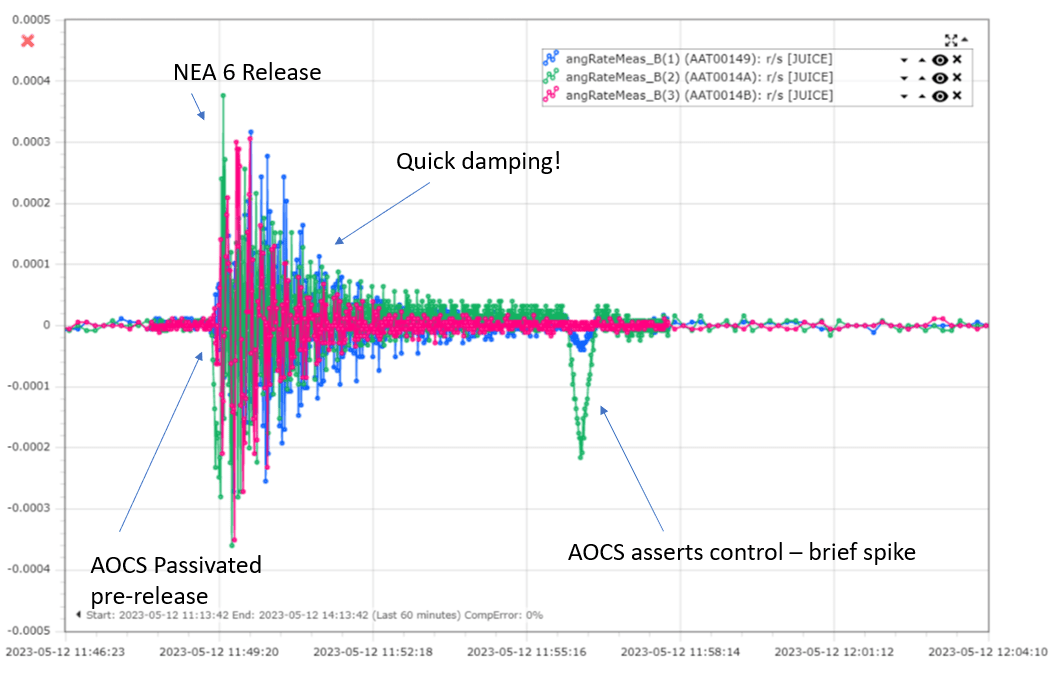After a month of trying, the radar antenna on the Jupiter Icy Moons Explorer (Juice) is finally unfolded and operable. The Radar for Icy Moons Exploration (RIME) antenna failed to deploy after launch, which flight controllers blamed on an errant pin. The problem has now been solved, leaving all 10 of JUICE’s instruments in working condition as it starts the long voyage to its gas giant destination.
To move the pin, flight controllers did what the rest of us do when dealing with errant equipment: they shook it. Not being able to do that by hand, they made Juice fire its thrusters to jiggle the pin. When this produced insufficient movement, they allowed sunlight to heat the craft up – still an option while it is whipping around the inner Solar System before heading for colder climes. Multiple jolts seemed to finally do it.
“On 12 May RIME was finally jolted into life when the flight control team fired a mechanical device called a ‘non-explosive actuator’ (NEA), located in the jammed bracket,” an ESA statement announced. “This delivered a shock that moved the pin by a matter of millimeters and allowed the antenna to unfold.”

The oscillations caused by the firing of the actuator (NEA 6). The swift dampening is a sign of the antenna being fully unfolded and wobbling until it locks into its correct position.
Image Credit: ESA
Although this unfolded most of the antenna, one portion remained recalcitrant, until a second actuator firing solved the problem.

The second stage of RIME’s deployment after the second use of a “non-explosive actuator”
Image Credit: ESA
JUICE will not reach Jupiter until 2031, although operations may start a little earlier when it passes the asteroid 223 Rosa. To save fuel it is taking a long and winding path, including flybys of Venus, Earth, and even the Moon to steal a little of their orbital velocity. Consequently, fixing the problem of the stuck antenna was far from urgent. On the other hand, after weeks of trying one solution after another without success, fears were growing, although Juice’s other instruments still looked set to provide plenty of useful data without RIME.
Nevertheless, RIME is an important part of the mission, expected to reveal subsurface structure on the target moons – Ganymede, Callisto, and Europa – to a depth of 9 kilometers (6 miles). Moreover, the European Space Agency (ESA) has a shorter history than NASA, so any failures loom larger in public, and possibly funders’ perceptions. After the failure of the high-profile Beagle lander on Mars, eventually attributed to solar panels not deploying, another incomplete mission would have been a major hit to ESA’s reputation.
Fortunately, however, Juice is now more likely to be a success ESA can point to in future when seeking funding for Solar System exploration. Indeed, its collaboration with the soon-to-be-launched Europa Clipper looks like being one of the most exciting scientific missions of the next decade.
As the name suggests, the Europa Clipper will focus on the smallest of Jupiter’s four big moons, considered to be one of the best prospects for finding life beyond the Earth. Meanwhile, Juice will make only two flybys of Europa, but will visit Ganymede and Callisto 12 and 21 times respectively. The capacity to compare what Juice learns about this pair with the Europa Clipper’s observations of their smaller sibling could prove more useful than either on their own.
Gérard the Sloth was not relocated in vain.
Source Link: JUICE Spacecraft’s Stuck Antenna Is Finally Freed, Clearing Path To Jupiter